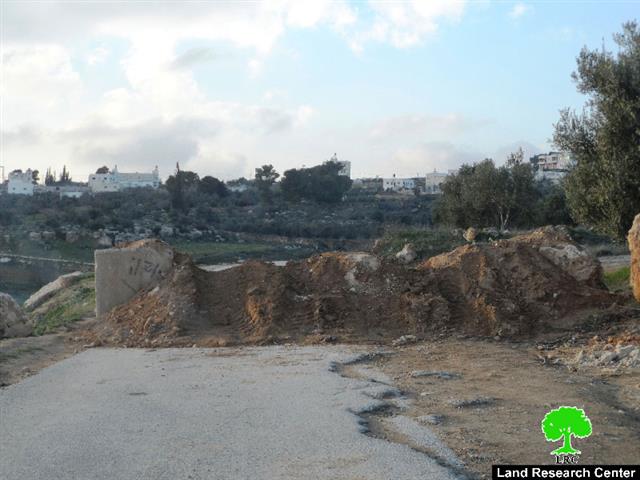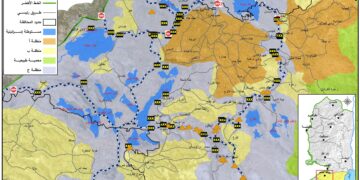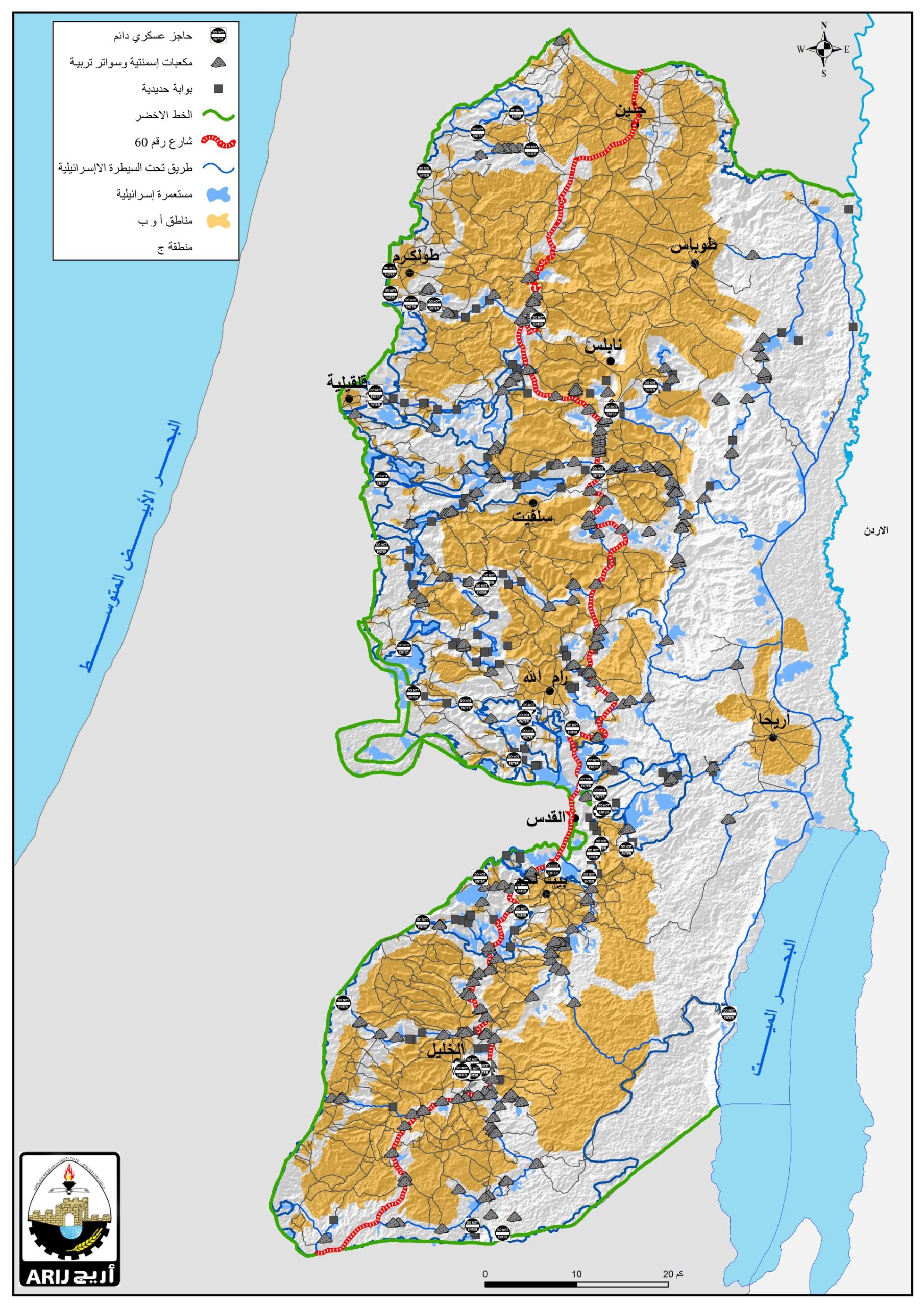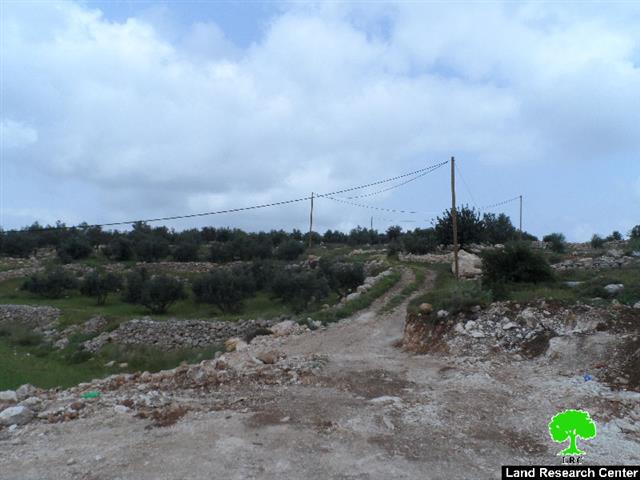The Israeli Occupation Forces reinforced by the end of 2015 closures on some towns and villages of Hebron governorate as a response to the latest uprising led by Palestinian youth. Closures took many shapes varying from road blocks (cement blocks), earth mounds to metal gates.
Not only, the Israeli Occupation Forces closed agricultural roads leading to citizens' lands; most of those closures were intense on sides of the bypass road number 60 that links Hebron to Bethlehem city, the bypass road number 317 that links Hebron and the southern village of Yatta town and Al-Dhahiriya-Hebron road that is an extension to the bypass road number 60.
The occupation was reported to increase the number of closures by November 20105; closures varied from permanent to temporary. Note that some closure are still effective until now.
Views of closures on entrances of cities and villages
The field research team at Land Research Center documented seventy closures on the entrances of towns, cities and camps in the Hebron governorate .This measure comes within the Israeli policy of collective punishment on unarmed civilians.
Land Research Center reported the entrance of Al-Fawwar refugee camp closed with metal gate since November 20105. Same case is reported on the eastern entrance of Dura city also known as Al-Fawwar junction.
Thirty nine other closures were reported to be via rocks and earth mounds in eight different Palestinian villages ; such closures were imposed on villages and towns' entrances and on some agricultural roads that link lands to main roads.
Also, twelve closures were reported set up via road blocks (cement blocks), eleven others via metal gates and three watchtowers. Noteworthy, the occupation is to establish five new checkpoints.
It should be marked that eight locations witness permanent checkpoints, where citizens and vehicles get hindered on daily basis on the claim of search and IDs' check.The following table shows the locations of permanent checkpoints:
|
Number |
Location of checkpoint |
The road links |
|
|
From |
To |
||
|
1 |
Ras Al-Joura "Jurat Bohlus" |
Hebron |
Bypass road #35 |
|
2 |
Wad Al-Sharq "Sa'ir entrance" |
Sa'ir town |
Bypass road #60 |
|
3 |
Al-Hawawer |
Halhul town |
Bypass road #60 |
|
4 |
Al-Haraiq "south Hebron" |
Bypass road #60 |
Hebron |
|
5 |
Al-Samou Junction "Rabud town" |
Bypass road #60 |
Al-Dhahiriya |
|
6 |
Al-Simiya "west Al-Samou" |
Bypass road #60 |
Al-Samou' town |
|
7 |
Beit Awwa |
Villages of west Dura |
Beit Awwa town |
|
8 |
Beit Ummar entrance |
Beit Ummar town |
Bypass road #60 |
Source : Field observation- Department of Monitoring Israeli Violations-
Land Research Center September2015- February 2016
A map illustrating the closures locations in Hebron
The Israeli Occupation Forces also closed the entrances of some towns, restricting residents movements. The towns of Deir Razeh, Abdeh, Wadi Al-Shajaneh and Hafayer Basm were closed by earth mounds and rocks.
Wadi Al-Shajaneh town was closed by earth mounds. It is 5km from Hebron and populates 1000 people. Travelers are now forced to take a route of 7km to Hebron instead of the original distance of 5 km only.
The area of Al-Fahs was closed via metal gate; the area links Hebron with Yatta villages and neighboring towns. Travelers are now forced to take a 17km route to reach Yatta instead of the original distance of 11km only.
The following table shows information about the closed cities and towns:
|
Number |
Towncamp |
Total of closures |
Type of closure
|
||||
|
Military checkpoint |
Metal gate |
Erath mound |
Watchtower |
Cement block |
|||
|
1 |
Al-Arrub camp |
4 |
1 |
1 |
0 |
|
2 |
|
2 |
Dura town |
25 |
|
3 |
21 |
|
1 |
|
3 |
Beit Ummar town |
8 |
|
1 |
5 |
1 |
1 |
|
4 |
Sa'ir |
3 |
|
2 |
0 |
1 |
|
|
4 |
Al-Samou' |
1 |
|
|
1 |
|
|
|
5 |
Halhul |
10 |
2 |
|
3 |
|
5 |
|
6 |
Bani Na'im |
3 |
|
|
3 |
|
|
|
7 |
Yatta |
3 |
|
1 |
2 |
|
|
|
8 |
Hebron |
11 |
2 |
3 |
2 |
1 |
3 |
|
9 |
Al-Fawwar camp |
2 |
|
|
2 |
|
|
|
Total |
70 |
5 |
11 |
39 |
3 |
12 |
|
Source : Field observation- Department of Monitoring Israeli Violations- Land Research Center September2015- February 2016
The Israeli Occupation Forces set up checkpoints on the claim of "Security of Colonists". Such policy is still ongoing since the Intifada of 2000; it restricts people's movement and bans others from opening and rehabilitating roads. In 2015, the Israeli occupation authorities served "removal" orders on roads on the claim of unlicensed construction. Here are some violations on roads :
- A stop-work and construction order on a dirt road in Yatta village (Ar, Eng)
- Israeli forces deliver stop-work notices in Hebron (Ar, Eng)
- Stop-work and demolition orders on agricultural roads in the Hebron town of Halhul (AR, Eng)
Land Research Center sees the closure as a restriction to the right to movement and that it contradicts all international conventions of related such like :
The Universal Declaration of Human rights1948:
- Article 3: Everyone has the right to life, liberty and security of person.
- Article 9: No one shall be subjected to arbitrary arrest, detention or exile.
- Article 13:
- (1) Everyone has the right to freedom of movement and residence within the borders of each state.
- (2) Everyone has the right to leave any country, including his own, and to return to his country
The International Covenant on Civil and Political Rights:
- Article 7 prohibits torture and cruel, inhuman or degrading punishment.
- Article 9 recognizes the rights to liberty and security of the person. It prohibits arbitrary arrest and detention, requires any deprivation of liberty to be according to law, and obliges parties to allow those deprived of their liberty to challenge their imprisonment through the courts
Prepared by
The Land Research Center
LRC





















